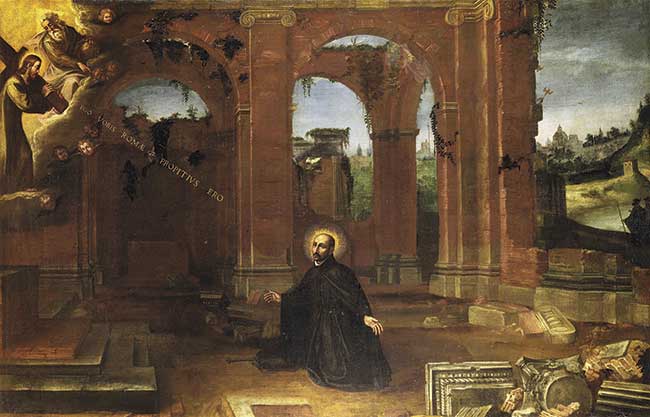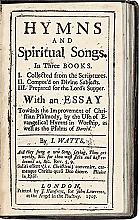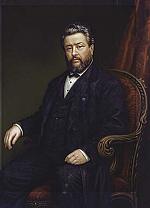A life of luxury meets the life of Christ

[Anonymous, The Vision of Ignatius of Loyola, c. 1622 to 1630. Oil on Canvas—Public domain, Wikimedia]
In seeking to share the full story of the faith, CH covered the Catholic Reformation in detail with issue #122. The full version of this article won the Cause of the Year Award at the Evangelical Press Association Convention in 2018.
Severely injured by a cannonball that had wounded both his legs, the young Spanish man knew his military career was over. In spite of the doctors’ dire predictions, he had survived surgery (no easy feat in a pre-anesthesia era) and was now learning to walk again.
This young man of wealthy birth and luxurious tastes had once longed only for battle and tales of chivalry, but now he had a growing interest in spiritual things; he was beginning to pray and meditate, desiring to follow God. He would make a pilgrimage to Jerusalem, he decided.
His first stop was the monastery of Santa Maria de Montserrat in Catalonia, Spain. There in March 1522, he bowed before a statue of the Virgin Mary. He left his military cloak and his sword before the image. When he arose he was to become a warrior in a different battle: the battle for the soul.
The young man, Ignatius of Loyola (1491–1556)—who would in 1540 found the Society of Jesus, or the Jesuits—was the youngest child of the noble Loyola family. His mother died when he was young, and his father when he was 16. Despite his personal tragedies, he enjoyed all the privileges and recreations of the aristocracy. One biographer later described him as a “fancy dresser, an expert dancer, a womanizer, sensitive to insult, and a rough punkish swordsman who used his privileged status to escape prosecution for violent crimes committed with his priest brother at carnival time.”
Two books as distractions
Ignatius showed little serious religious inclination until those catastrophic events at the Battle of Pamplona in 1521. After his wounding and surgery, he spent months in recovery at the Loyola castle, with only two books to distract him from his world of pain: The Golden Legend (c. 1260), a best-selling collection of the lives of the saints, and Ludolph of Saxony’s The Life of Christ (1374), a harmony of the Gospels drawing on the writings of the church fathers.
Together these books changed Ignatius’s life. In contrast to the dread and depression he experienced when he thought of returning to his life, the lives of Christ and the saints filled him with a sense of “consolation.” Ignatius decided that he wanted to spend the rest of his life ministering to others, or as he called it, “helping souls.” Upon recovery he withdrew in retreat, prayer, and pilgrimage.
In this time he crafted the guides to devotion known as the Spiritual Exercises (published in 1548). Ignatius decided he would need more theological education and formation if he was going to dedicate his life to helping souls, and he enrolled at the University of Paris to get it. There he connected with other students who would form the original core of the Jesuits, spending time with them in prayer and leading them through the Exercises. On August 15, 1534, they vowed to obey the pope, practice poverty and chastity, and make a missionary voyage to the Holy Land.
Finding delays at every turn, they spent their days of ministry first in Venice, and then in Rome, where, through prayer, discussion, and discernment, they decided to seek papal approval for their new order. In 1540 they secured approval from Pope Paul III, swearing to obey any call to be sent anywhere in the world to preach the gospel and care for the sick.
Early Jesuits established missions as far as South America, India, China, Japan, and the Philippines. However, they also emphasized a vow of obedience to the pope, sometimes controversially so. But “the desire for a more devout life” drove the Jesuits, who prayed to God with Ignatius, “Give me Thy love and Thy grace, for this is enough for me.”—Katie M. Benjamin, from CH #122
By Katie M. Benjamin
[Christian History originally published this article in Christian History Issue #150 in 2024]
Katie M. Benjamin directs the Divinity School Library and teaches church history at Duke University.Next articles
Johns worth knowing
A persecuted preacher, an innovative evangelist, and an "old African blasphemer"
E. Beatrice Batson, J. D. Walsh, Aubrynn WhittedThe golden age of hymns
Songs that spoke the language of Christian faith and aspiration
Vinita Hampton WrightFounding fathers
An innovative evangelist, a Christ-based preacher, and a pioneer missionary
James E. Johnson, Patricia Stallings Kruppa, Timothy GeorgeSupport us
Christian History Institute (CHI) is a non-profit Pennsylvania corporation founded in 1982. Your donations support the continuation of this ministry
Donate







